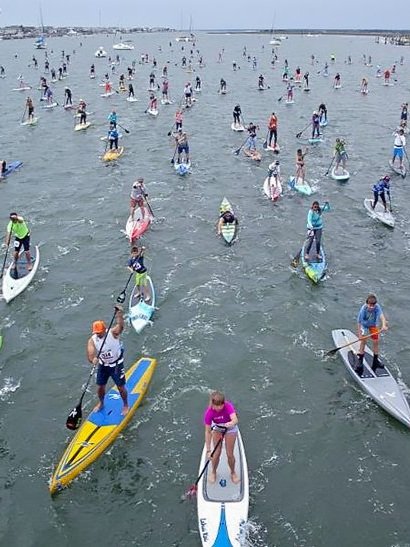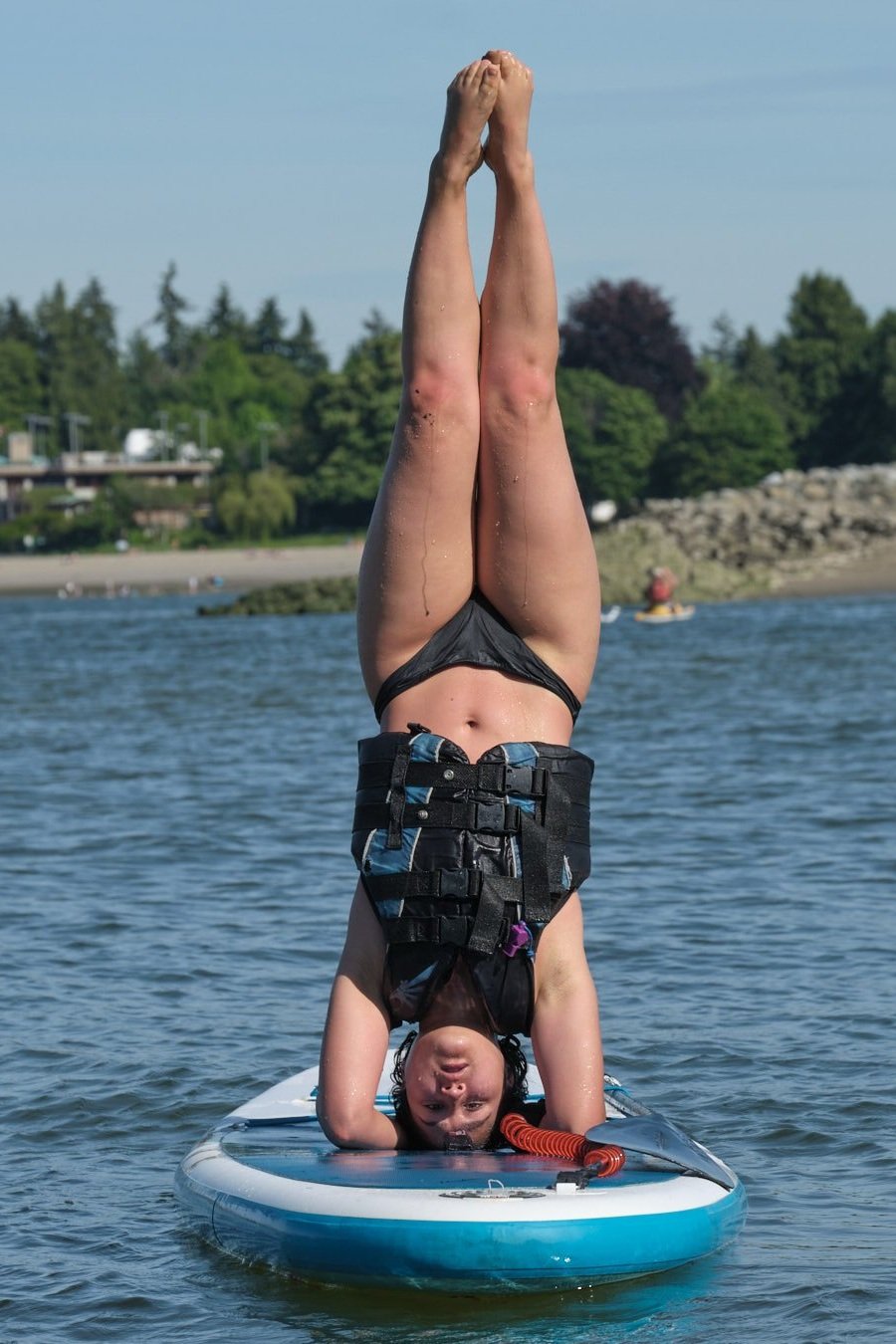Paddleboarding came to be in the 1960’s on the beaches of Hawaii, and since then has expanded across the world and is now the fastest growing watersport. At first, introducing a paddle with a long board as a way for surfers to gain an advantage when out on the water and make it easier to catch the next wave. Now paddling with a board has become its very own watersport! Stand up paddleboarding, also known as SUP, has changed since its inception. It has evolved over time into different forms to be enjoyed by people of all ages with varying backgrounds. But why exactly is it now the fastest growing watersport?
SUP is friendly to all ages and abilities
Whether a person is 80, or 8 years old, paddleboarding is accessible- it’s able to be enjoyed by people of various ages and skill. With inflatable board options, the equipment has never been lighter, making transporting the equipment much more manageable for persons of any age. Paddling on a SUP board is also low intensity as participants can paddle at their own pace. This makes it ideal for those who want an easy, relaxing time, but who still want to get active on the water. The sport can be great even for those who struggle to stand for long periods or have a hard time balancing on the board while standing. SUP riders can kneel, or even sit down on the board as they paddle, making for a laid back ocean adventure. This is the best option for taking kids out on a paddle, as two smaller children can double up on the board, sitting at the front and back of the board, adding an element of teamwork to the watersport.
Don’t want to leave your pets at home? No need, even your furry friends can join you! Place your pet on the board before you launch, bring a few treats to keep them content, and start enjoying the best watersport along with your best friend; just don’t forget their lifejacket!
Paddleboarding offers a friendly, competitive space
The watersport is great as a hobby, providing a way for users to get out active at their own pace and leisure. Paddleboarding has many recreational applications, but it also has a competitive side. The biggest SUP tournaments attract thousands of contestants as they push their endurance and paddling skills to the limit. These races take place across the world and involve racers covering vast distances in a variety of conditions. Some of these challenging, world-renowned races include the Carolina Cup, Air France Paddle Festival, and the Hanohano Huki Ocean Challenge. Competition here is more of a subjective term, as these races involve both pros and amateurs alike, coming together to enjoy a friendly competition and share their love of the sport with fellow enthusiasts. While these competitive races do determine the best of the best in the sport of paddleboarding, they can also serve to build community around the sport, as well as benefit those outside the community. The Standup for the Cure event combines racing, with fundraising and community building efforts. This event encourages health and fitness, in addition to raising money for early breast cancer detection.
It can be a starting place for other activities
Stand up paddleboarding can be more than just a hobby and a sport, it can lead to many different kinds of water adventures. If you are fond of backpacking and camping, combining it with a board and a paddle can lead you to secluded spots you would never be able to get to on foot. Also known as expedition SUP, stand up paddleboard camping is excellent for any water side trip. Grab a good dry bag, tie it down on the front bungee straps that come standard on most inflatable, and you are well on your way to explore the most secluded yet beautiful camping spots by the water. Another outdoor activity that goes naturally with SUP is fishing! No need to scare away fish with a noisy motor, or take up precious storage space with a kayak when an inflatable board and a paddle is all you need. If you prefer a “set it and forget it “ way to catch yourself some fresh seafood, you can even go crabbing. Just make sure you get a board with enough deck space to carry your equipment (fishing pole, tackle box, crab pot, etc.).
If fitness is more your focus, yoga is an excellent way to spice up your outings on the water. Doing yoga on a paddleboard adds another degree of balance to the yoga poses. It also gives you much better scenery than any yoga studio could provide.
With all these activities you are able to combine with the wonders of the watersports, never forget that the best adventures are the ones that are shared. So if you decide to go camping, fishing, crabbing, or try out some yoga on the water, remember to bring your best pals along to have the best experience possible.
SUP provides a full body workout
Stand up paddleboarding is a great way to get your heart pumping and your muscles working. Longer expeditions will offer robust cardio, giving a great workout to your heart and lungs. The actual act of using a paddle also works out the stomach, shoulder, chest, and back muscles. Standing and balancing on a board targets the quads, glutes, and calves. Tower Paddleboards has an excellent infographic breaking these muscle groups down, as well as a ton of other handy information! Though targeting the main muscle groups are great if you are working towards your overall increased fitness, the balancing on a board alone targets very specific muscles. The constant tiny adjustments when balancing works out the micro-muscles in your leg that otherwise go unused during other workouts that involve bigger movements. As mentioned previously, SUP allows the user to go at their own pace. With this, stand up paddlers are able to go fast in short bursts for some high-intensity interval training (HIIT), but also slow things down and go low-intensity steady-state training (LISS), both of which offer their own benefit (which you can read more about HERE).
Take your paddle and board anywhere
While all the reasons listed above contribute to the sport gaining popularity in recent years, the biggest factor would still have to be the freedom that the sport offers. For a long time, the only boards available for SUP were solid, long, and heavy. These issues did not apply to inflatable options, which came to market around 2008. But while inflatable boards have been available for over a decade, it wasn’t until the past few years of lockdowns that people were forced to find hobbies where maintaining space from others was easy. So, during the first few years of COVID, paddleboard sales surged as individuals saw the benefit of an outdoor hobby done in the open air and allowed for social distancing. The lightweight and compact inflatable boards gave people the freedom to get outside their homes, and go wherever the water calls them! As a bonus, most inflatable SUP boards come with a handy backpack and collapsible paddle for easy transportation. For example, at Windsure, most of our rental and teaching fleet is made up of the Red Paddle Co. Ride, which features the ATB Transformer Board Bag. Any adventure outside your neighborhood that is near water, now has the potential for a paddleboarding excursion. The ability to easily transport a watercraft anywhere you go reanimates any vacation by a lake or beach and is an absolute necessity in having the best time possible.
Stand up paddleboarding has introduced many different people to new and easy adventures on the water, allowing opportunities for both recreational, as well as competitive outlets. Though COVID may have been the catalyst that began this surge in popularity, it is the many benefits of the watersport that has kept people happily on a board with a paddle in hand. The increasing number of people recognizing the wonders of SUP is only going to increase as more paddlers introduce their friends and family to one of the best and fastest growing watersports available.



